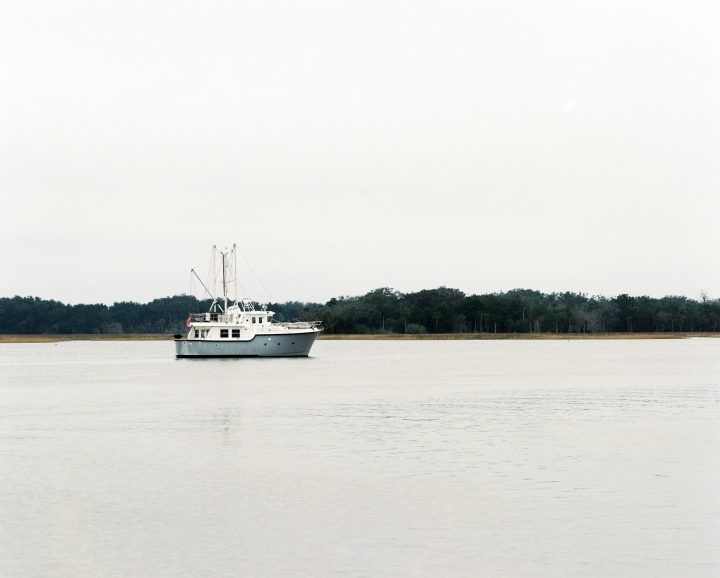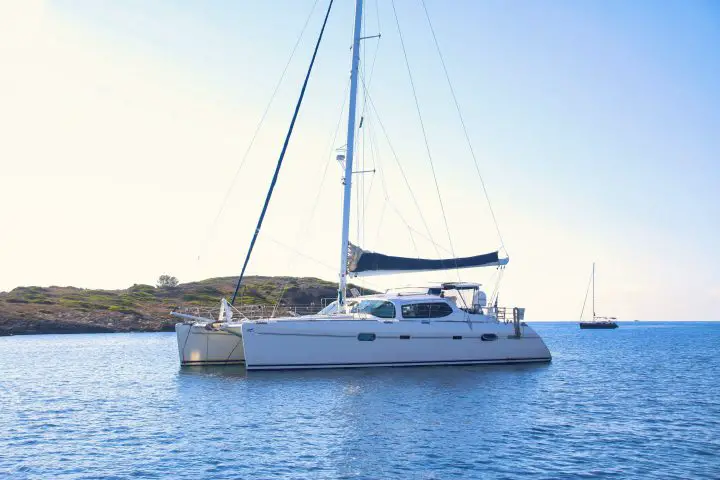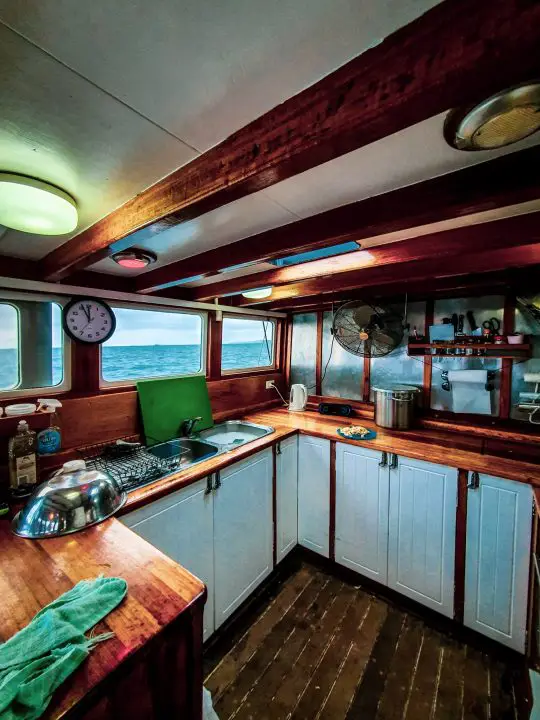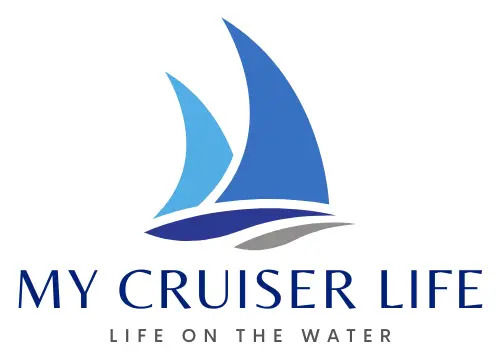What could be more romantic or inspiring than living on a sailboat? Maybe you dream of traveling and “sailing off into the sunset.” Or maybe you dig the sailing lifestyle and are looking to join a community of like-minded people. For some, it has been a lifelong dream. Or perhaps you’ve landed here because you’re out of options, and life on a sailboat sounds cheaper than land-based obligations and a good way to save money.
Table of Contents
- The Dream of Sailboat Life
- Can You Live Aboard Any Boat?
- Buying a Sailboat to Live On
- Pros and Cons of Life on a Sailboat
- Before You Do, Try Life On a Sailboat First
- Sailboat Life FAQs

The Dream of Sailboat Life
The truth is, many reasons bring people to move onto a sailboat—or any kind of boat. If you’re unfamiliar with boat life, think of boats as floating RVs or campers. They attract all sorts of people, from wealthy travelers to people making ends meet. And just like with RVs, they range from palatial yachts to cramped, dingy things you can’t get away from fast enough.
Buying a sailboat to live on has grown in popularity in recent years and has boomed during the coronavirus era. While the global pandemic certainly slowed world travel, it has pushed more people to work from where ever they like. With unlimited data cell phone plans, you can take your boat nearly anywhere and still be connected with the world.
Can You Live Aboard Any Boat?
The first question to ask is, “What sort of boat do you want to live on?” Boats come in every shape and size to suit every boater. As a result, the choices can be overwhelming when you first consider the lifestyle.
All boats represent compromises. The vessel designer made compromises to fit all the things in the boat that they could. There are compromises in performance in favor of more creature comforts, or vice versa.
Likewise, you’ll make compromises when you purchase a boat. You may find that the vessel of your dreams is out of your budget, so you compromise with a smaller boat or one lacking some features. You may opt for a stout bluewater boat built for ocean crossings. If that’s the case, you will invariably compromise on some liveaboard comforts that cheaper coastal cruisers might offer.
What the boat needs to have for you to liveaboard is entirely up to you. Is your idea of the liveaboard lifestyle all about downsizing and living simply? Or is living aboard a means to an ends—a way to slowly travel the world comfortably while taking “home” with you? Do you live for the passion of actual sailing, or is sailing just a cheap way to move from place to place?
In other words, before you go boat shopping, you must narrow down your goals for the vessel. Next, we’ll look at some of the features that will make how to live on a sailboat easier, but remember that nothing is mandatory.
Buying a Sailboat to Live On
If you’re wondering whether or not sailboat life is right for you, start by thinking about what the perfect setup would be like. Chances are you have some preconceived notions of what living on a sailboat is like. And chances are there are ways that it could be like that, but there are also ways that it could be completely different.
Sail or Power?
Before you dive too deep into the lifestyle, don’t pigeonhole yourself into looking at only sailboats. There are tons of powerboats that you can get for similar prices as used sailboats. And motorboats have a few advantages over sailboats, especially for living aboard.
The most common types of powerboats you’ll see people living on are trawlers or cabin cruisers. First, the design of these boats means that their hull shape is better able to accommodate living space. They’ve got wide sterns and bigger interiors. They also usually have large windows and a nice view out of the living area, something most sailboats lack.
The only thing that a powerboat can’t do is sail (obviously), and most people don’t cross oceans in them. But most people who buy sailboats to do those things never actually do them! So again, it all comes back to being honest with yourself about what you want to do with your boat. If you’re after comfortable living space and the ability to travel anywhere along the coast, a trawler should be high on your list.

Price Range
You can’t go boat shopping (or even dreaming!) without at least some idea of your budget. You can spend anywhere from $1,000 to well over $10 million buying a sailboat. You have to narrow it down a bit!
Here are a few pointers to guide you. If you browse for a boat on Yachtworld, you can get a pretty good idea of a particular make and model’s nominal value.
These are brokered boats, so the list prices seldom equal the sale price. But it provides a good way to analyze the market. Some will be priced very high because they are newer, have newer upgraded engines, are better maintained, or are otherwise “better.” By eliminating those, you should be able to estimate the average value of a particular make and model.
You may find listings that look like bargains because they are priced lower. Chances are, these are project boats. Project boats require “elbow grease” or “DIY skills” to restore. A project boat is always a losing proposition because it will usually take many more dollars to get it ship-shape than it would cost to have just bought the kept up boat to begin with.
Here’s an example. Say you’re shopping for one of the best liveaboard sailboats, like a Catalina 30, and the average price is around $18,000. Then, one day while browsing Craigslist, you see one listed for $5,000. A bargain, right? Well, it should be no surprise that the $5,000 boat “needs a little work.” But what you might not realize is that it probably needs $20,000 or more worth of work (and even that number is if you plan on putting in your own elbow grease).
The moral of this story is pretty simple—plan on paying the average price for a sailboat. Of course, there might be some bargains out there. But generally, if you want a functional, livable boat, it will cost you some cash.
Monohull or Catamaran
Catamarans are popular choices for liveaboard boaters, especially if you plan on anchoring or traveling a lot. These boats have expansive living spaces that feel much less crowded and claustrophobic than typical boats. Even sail cats ofter raised salons with wrap-around windows and lots of fresh air flowing through.
On the flip side, it can be challenging and expensive to find a dock or repair facility in some parts of the world when you need one. So if you plan to live at a dock on a catamaran, start your search by finding the dock first. Catamarans are too wide to fit in regular slips, so marinas must put them on the limited number of bulkhead or t-head docks they have.
Catamarans are expensive, and it’s generally not good to stretch your budget when buying a boat. If you do, you’ll have less money in the back to travel or spend on upgrades and repairs. So if the catamaran lifestyle appeals to you, double-check your numbers to ensure you can afford to do it right.

Dock Life or Off the Grid
Being a liveaboard boater does not mean you must spend your life tied to a dock. You could travel regularly from your marina home base. Or you could travel and not have a home base. It all depends on how you organize your life and your obligations.
If you intend to live as off-the-grid as possible, that should be considered when you go boat shopping. Some boats are easy to set up that way, and others are not.
If you spend a lot of time away from docks, you must come up with a plan to get some necessities. Some things are easy, and others are more difficult. You’ll have to answer questions about how you will get electrical power, fresh water, pump outs, fuel, and groceries.

Electrical Power
At a dock, you can plug in with a large extension cord and enjoy unlimited power just like you would in a home. Since all the power arrives through the one big cord, there might be some inconveniences, like you cannot blow dry your hair, make microwave popcorn, and brew coffee all at once. But generally, you’ll have outlets that work and plenty of power to run air conditioners, heaters, cooking appliances, and whatever else.
Away from the dock and unplugged is another thing entirely. Some boats have generators that will run 24/7 to maintain the same comforts. But generators drink diesel fuel and are noisy and smelly. Most sailors who live off the grid prefer to use solar panels and a large bank of batteries to power what they need. In all but extreme cases, however, this means that some power-intensive conveniences like air conditioning and heaters are not viable options.
Fresh Water
Docks will supply city or well water for use onboard. In some cases, you plug in a hose for unlimited supply, but on most boats, you simply fill up the water tanks whenever you need to.
Away from the dock, you’ll have to rely on the tanks alone. When they get low, you’ll need to visit a dock to refill them. Any marina will let you fill up, but most boaters combine it with a trip for fuel or a pump out.
Some boaters catch rainwater and put it in their water tanks. Others carry jerry cans of water from shore in their dinghy. And on ocean-going boats, you can install water-making systems that desalinate seawater and make it potable.
Pump Out
If water goes in the boat, it must come out, right? It is illegal to dump your toilets overboard in most parts of the world unless you are far offshore. So boats are equipped with a holding tank—the boat equivalent of the RV black water tank.
To empty the tank, you visit a pump out station. This is simply a pump that takes the tank contents and puts them in the local sewage treatment system. It is far more ecologically responsible than dumping it.
The size of your holding tank is a significant limiting factor on most liveaboard vessels. On average, a 20-gallon tank will last a couple about one week of full-time living aboard. So plan on a weekly trip to the pump out dock. You can just use the marina’s facilities as often as possible if you live at a dock. That will extend your time between pump outs considerably.
Some places have pump out boats that will come to you. This is common in busy mooring fields or anchorages like those found in Florida. Some are provided by marinas, and others are done by local cities or counties. Interested in liveaboard marinas in Florida, visit our guide!
Fuel
Living aboard doesn’t burn any engine fuel. And it’s usually easy to find gas or diesel fuel docks when traveling.
But you’ll also occasionally need cooking fuel, usually propane. You may also need fuel for your heaters during winter. Boat heaters work on diesel, propane, or solid fuels.
Groceries
Finally, you’ll need a plan for groceries. For example, if you live at a dock at a marina, you might keep a car there and live like you would if you had an apartment.
If you don’t have a car or are traveling, you will start looking for grocery stores near marinas. Walking distance becomes important, as do marina loaners cars or Uber.
Living Spaces
You can make a lot of upgrades and modifications to make the boat you choose, but it’s not possible to fundamentally change the boat’s characteristics. If you’re thinking about living on a boat full time, you need to consider the living spaces and whether or not you and your family can comfortably live there.
Salon, Cockpit, and Staterooms
You’ll spend most of your time in the larger spaces, like the cockpit and salon. The cockpit is like the outdoor patio, and the salon is like your living room and dining room combined. Do these areas have enough space for everyone to lounge comfortably? What about regular everyday things like reading a book or watching the tv?
Designers make boats comfortable and safe while boating, but it’s only recently that they’ve emphasized the livability aspect of their designs. As a result, many sailboats have small cockpits that are safe at sea but cramped for day-to-day life. Likewise, settees and lounges might not be engineered for comfort so much as use in rough seas.
A common complaint that people have about boat life is the shape of the beds. Staterooms on small boats usually have v-berths, vee-shaped cushions in the bow. These can be very difficult to get in and out of, especially for couples. They nearly always involve getting trapped inside and having to climb over your partner to get out. Island berths, which stand in the center of the stateroom and can be accessed on either side, are a great upgrade.

Galley and Head
And then there are the functional parts of the boat like the kitchen and bath (or the galley and head in boating terms). Kitchens will be much smaller than even efficiency apartments. Expect a simple gas range and small oven at the most. Some boats will have a microwave, but not all. Refrigerators are small, and on sailboats, they are often awkward top-loaders. The biggest problem you’ll find with most boat galleys is a lack of counter space and storage.
The head is another place to analyze what living aboard would be like. Smaller boats have “wet heads.” That means that if you want to have a shower, you’ll sit on the toilet, and everything will get wet. The opposite of a wet head is a separate shower stall, which is a great upgrade if you are living aboard full time.
Pros and Cons of Life on a Sailboat
So now you’ve got some ideas about what makes up life on a sailboat—or at least a look at the variety and sorts of boats that you can liveaboard. What would make you want to take the plunge, and what would give you pause? Here are a few pros and cons to the liveaboard lifestyle.
Five Reasons Boat Life is Awesome
1. Freedom
Living on a sailboat provides an amount of freedom that people with houses can never know. Don’t like your neighbor? Change slips or move to a new marina. Sick of this town? You and your house can be in another state in a few days.
Not being tied down means you can organize your life to travel more. For example, if you aren’t tied to a local job, you could spend summers staying cool in New England and winters in Florida or The Bahamas. Or if you’re entirely untied, head off into the sunset for the Caribbean or an around the world cruise.
2. More Time On the Water
It only follows that you must like the water if you’re looking at boat life. Many people feel a special connection to nature from being near the sea, be it at the beach or on a boat. Boats provide you with endless million-dollar waterfront views that can change as much as you want to travel. You’ll enjoy your morning coffee with a whole new crowd—pelicans, dolphins, sea turtles, and manatees may be in your backyard every morning.

3. Romantic, Slow Paced Travel
Even if you don’t cruise, there is a romantic connection to travel in every boat. Arriving in a new town by boat is unlike any other travel experience. Every town looks like the same strip malls and chain stores by car. But by boat, you can see towns like an explorer, viewing each historic waterfront and finding all the best dive bars and cruiser hangouts.
With the right sailboat, you can travel nearly anywhere in the world. Some people dream of completing a circumnavigation, while others stick to seasonal cruising. Whatever your goal, sailboats might not be the fastest way to travel, but they are certainly the most romantic.
4. Small Space Simple Living
On the one hand, boats and RVs are the mobile equivalents of the tiny house. If the idea of downsizing your possessions and valuing experiences more than material goods appeals to you, living in the small space of a liveaboard boat might be right for you.
It might seem counterintuitive because boats are pretty complex and expensive items. But downsizing is a relative thing, and no matter how fancy the boat is, chances are the people living on it downsized their lives to get there. Boats themselves are complex, but they also prevent you from being burdened by many non-essentials.
5. Sailing Community
Finally, the sailing and boating community is full of interesting and fun people. Everywhere you go, you’ll meet boaters that come from a wide range of backgrounds who have similar interests to your own. The community is supportive and known for fun get-togethers over cocktails or pot-lucks.
Five Reasons Why a Liveaboard Boat Can be a Bummer
1. Difficult to Find Liveaboard Marinas
If your goal is to live on a boat and stay in one place, you might find it’s hard to get a marina or anchorage that suits you. Marinas are businesses, and each one is operated to suit a particular crowd. Some welcome liveaboards while others do not. Sometimes it’s the marina policy, and other times it has to do with local city or state regulations.
However, if you are traveling on your boat as a cruiser, you have little to worry about. Travelers and voyagers are always welcome, and transient slips at marinas for up to three months are usually readily available.
2. Small Spaces
Wait, wasn’t “small living” a pro of living on a boat? It was, but it can suck too. Cramped spaces, storage limits, and small living get old and frustrating after a while. No matter how hard you try, you’ll wind up collecting too much stuff that you have no room to store. Downsizing is a process, not a one-time event when you live on a boat.
And then, there are the problems that stem from sharing a small space with your partner or family. Boats offer very little in terms of private space. Even if you get off the boat everyday and travel, living together so closely for any length of time will test any relationship to the breaking point.
3. Constant Maintenance Costs and Fixing Things
Boats are constantly breaking. They float in an acidic solution 24/7, are subject to constant motion and vibration, and are full of explosive substances and toxic chemicals. Sometimes it seems like they are willfully trying to self-destruct and take you to the bottom of the ocean.
Of particular note regarding crew morale are those ever-constant maintenance issues related to the toilet plumbing. Marine heads stink—but literally (sometimes at least) and figuratively in their design and function.
Engine problems are also a big concern, primarily for their expense. A new engine can easily cost more than you paid for the entire boat!
Repairs on boats slow down after the first year of ownership once you handle everything the vessel needs. But by then, your time will be full of preventative maintenance tasks to keep it all working well. As the saying goes, an ounce of prevention is worth a pound of cure.
4. It’s Really Very Slow
If you’re buying a boat to travel, you might be shocked at how little traveling you can get done. Boats travel at the whim of the weather, which often means sitting in port and waiting for better conditions. There’s a lot more sitting and waiting than actually sailing. If you’re coming from the land-based road world, this is a stark contrast to hopping in your car and driving off whenever you feel like it.
Even when you do travel, moving between five and seven miles per hour is slow. What can be done in one day in a car now takes you three to four 24-hour days of constant travel.
5. Sometimes, It’s the Worst
Maybe that’s mellow dramatic, but experienced sailors will understand the sentiment. But sometimes, it just seems like the weather or entire ocean is trying to kill you.
Then, there’s the constant inconvenience of it. Just getting a cold beer out of the fridge might involve clearing the countertop, opening the lid, taking out two top shelves, and leaning down at the very bottom to find the last bottle. Then, there are marina wifi problems, seasickness in rolly anchorages, and boat parts lost in the mail or stuck in customs.
Like many choices you make in life, living on a sailboat is not about the boat or the place. It’s all about your attitude. Is it an adventure or a nuisance? Of course, everyone experiences inconveniences once in a while, no matter where they live. But boats make everything seem more dramatic, causing you to doubt your choices at the first signs of discomfort.

Before You Do, Try Life On a Sailboat First
It’s hard to describe both the pleasure and the dispair that living on a boat can provide. It’s been said that for every low-low, like a back-flowing toilet, there are high-highs, like the perfect sunset with dolphins dancing just for you.
From my observations, most people who move aboard give it up after their second or third year. Unfortunately, many don’t make it past year one, which is always the hardest due to the steep learning curve.
The best advice is to try sailboat life before you buy into it. Charter a boat or take some sailing lessons. Find friends with boats who will take you out and share their stories with you. Do research, go to boat shows, and try it out in any way you can before taking the plunge. And no matter what you do, remember to enjoy and savor the adventure!
Sailboat Life FAQs
Is living on a sailboat worth it?
I think so, and many others do too. But living on a sailboat is not for everyone. Boats range from luxurious yachts to cramped, floating tents. No matter what size boat you choose to live on, there will be times when you doubt that it’s worth it.
All boats are cramped and uncomfortable at times. Life revolves around the weather, the boat, and staying safe. Sometimes it means getting out of bed at 2 am to move the boat in a storm, and sometimes it means not joining your friends at the beach party because something broke and you need to fix it.
It’s impossible to answer whether or not living on a sailboat is worth it to you—only you can make that call. This is because sailboats offer not only a way to travel but a way to completely change your life.
Can you legally live on a boat?
Yes, you absolutely can live on a boat. But depending on where you want to live, it can be challenging to find marinas or anchorages that will allow you to. There is nothing inherently illegal about living aboard a boat, but liveaboards are frowned on by many dockmasters and local governments. However, you can find liveaboard marinas, and many have lovely, welcoming communities of people who love their vessels, the water, and the sailing lifestyle.
